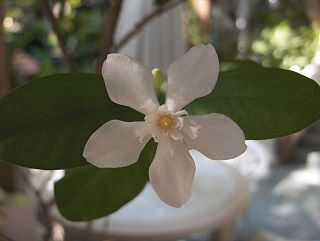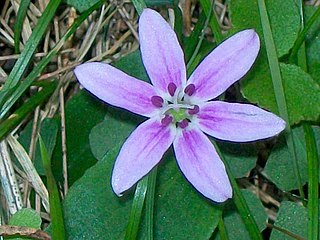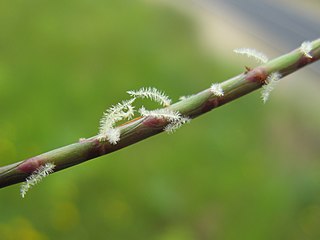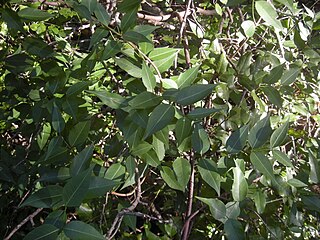
Wrightia is a genus of flowering plants in the Apocynaceae (dogbane) family, first described as a genus in 1810. It native to tropical Africa, China, the Indian Subcontinent, Southeast Asia, Papuasia, and Australia. The species are all small trees or shrubs.

The Teasel Banksia is a species of small shrub in the plant genus Banksia. It occurs on the south coast of Western Australia from Fitzgerald River National Park east to Israelite Bay.

Banksia nivea, commonly known as Honeypot Dryandra, is a shrub endemic to Western Australia. The Noongar peoples know the plant as Bulgalla. First described as Banksia nivea, it was transferred to Dryandra as Dryandra nivea by Robert Brown in 1810, and remained in that genus until 2007, when all Dryandra species were transferred to Banksia by Austin Mast and Kevin Thiele.
Lepturus is a genus of plants in the grass family, native to Asia, Africa, Australia, and various islands in the Indian and Pacific Oceans.
- Lepturus anadabolavensisA.Camus - Madagascar
- Lepturus androyensisA.Camus - Madagascar
- Lepturus boinensisA.Camus - Madagascar
- Lepturus calcareusCope - Socotra
- Lepturus copeanusB.K.Simon - Australia
- Lepturus geminatusC.E.Hubb. - Australia
- Lepturus humbertianusA.Camus - Madagascar
- Lepturus minutusB.K.Simon - Queensland
- Lepturus nesiotesCope - Socotra
- Lepturus perrieriA.Camus - Madagascar
- Lepturus pulchellus(Balf.f.) Clayton - Socotra
- Lepturus radicans(Steud.) A.Camus - Kenya, Tanzania, Malawi, Mozambique, Zimbabwe, Madagascar, Comoros, Mauritius, Seychelles, India
- Lepturus repens(J.R.Forst.) R.Br. - Somalia, Kenya, Tanzania, Mozambique, KwaZulu-Natal, Madagascar, Chagos Is, Mauritius, Rodrigues I, Aldabra, Lakshadweep, Sri Lanka, Andaman Is, Paracel Is, Thailand, Vietnam, Taiwan, Japan, Cocos Is, Malaysia, Indonesia, Philippines, Christmas I, New Guinea, Solomon Is, Australia, many of the Pacific Islands
- Lepturus tenuisBalf.f. - Socotra
- Lepturus xerophilusDomin - Australia

Eleocharis is a virtually cosmopolitan genus of 250 or more species of flowering plants in the sedge family, Cyperaceae. The name is derived from the Greek words ἕλειος (heleios), meaning "marsh dweller," and χάρις (charis), meaning "grace." Members of the genus are known commonly as spikerushes or spikesedges. The genus has a geographically cosmopolitan distribution, with centers of diversity in the Amazon Rainforest and adjacent eastern slopes of the South American Andes, northern Australia, eastern North America, California, Southern Africa, and subtropical Asia. The vast majority of Eleocharis species grow in aquatic or mesic habitats from sea level to higher than 5,000 meters in elevation.

Ternstroemia is a genus of flowering plants in the family Pentaphylacaceae. It is distributed in tropical and subtropical regions in Africa, Asia, and the Americas.

Enchylaena is a genus of two species of small perennial shrubs endemic to Australia. Plants of this genus are commonly known as barrier saltbushes.

Dryandra subg. Hemiclidia is an obsolete plant taxon that encompassed material that is now included in Banksia. Published at genus rank as Hemiclidia by Robert Brown in 1830, it was set aside by George Bentham in 1870, but reinstated at subgenus rank by Alex George in 1996. In 2007, all Dryandra species were transferred into Banksia at series rank, and the infrageneric Dryandra taxa, including D. subg. Hemiclidia, were set aside.

Bellendena montana, commonly known as mountain rocket, is a species of low-growing multi-stemmed shrub in the plant family Proteaceae. It is endemic to high-altitude subalpine and alpine regions in Tasmania, Australia. The prominent white flower spikes appear over summer, followed by small bright red or yellow fruit in late summer and autumn.

Acidonia microcarpa is a species of shrub in the plant family Proteaceae. It is the only species in the genus Acidonia. It is endemic to the south coast of the Southwest Botanic Province of Western Australia.

Olea paniculata, commonly known as the native olive, is a plant of the genus Olea and a relative of the olive. It grows natively in Pakistan and southwestern China (Yunnan) through tropical Asia to Australia and the Pacific islands of New Caledonia, Vanuatu and Lord Howe Island.

Schelhammera is a genus of perennial flowering plants in the family Colchicaceae, comprising two species.
Coelachne is a genus of Asian, African, and Australian plants in the grass family.
- Coelachne africanaPilg. - tropical Africa incl Madagascar
- Coelachne auquieriNdab. - Rwanda
- Coelachne friesiorumC.E.Hubb. - Aberdare Range in Kenya
- Coelachne ghaticaNaik - Western Ghats in India
- Coelachne infirmaBuse - Madagascar, New Guinea, Maluku, Sulawesi, Philippines, Java, Sulawesi
- Coelachne japonicaHack. - Honshu, Kyushu
- Coelachne minutaBor - Thailand, India
- Coelachne perpusilla(Nees ex Steud.) Thwaites - Tamil Nadu, Sri Lanka, Laos, Thailand, Vietnam, Philippines
- Coelachne pulchellaR.Br. - Myanmar, Vietnam, Queensland, Northern Territory
- Coelachne simpliciuscula(Steud.) Munro ex Benth. - Madagascar, Indian Subcontinent, China, Indochina, Philippines, Malaysia
- Coelachne soerenseniiBor - Thailand

Hemarthria is a genus of herbaceous plants in the grass family. They occur in the tropical and subtropical Old World, especially in China and Southeast Asia, with some species in Africa, Australia, and southern Europe. They may be known generally as jointgrasses.
- Hemarthria altissima(Poir.) Stapf & C.E.Hubb. - limpograss, African jointgrass, Batavian quick grass, halt grass - China, India, Indochina, Borneo, Madagascar, Mauritius, Middle East, Caucasus, Africa, Canary Islands, Spain, Italy, Greece; naturalized in parts of North + South America
- Hemarthria compressa(L.f.) R.Br. - whip grass - China, Japan, Indian Subcontinent, Indochina, Borneo, Afghanistan, Iraq, Comoros
- Hemarthria debilisBor - Thailand
- Hemarthria depressaHeuvel- Laos, Vietnam, Thailand, Malaysia
- Hemarthria hamiltonianaSteud. - India, Bangladesh
- Hemarthria longiflora(Hook.f.) A.Camus - China, Indian Subcontinent, Indochina, Borneo
- Hemarthria natansStapf - eastern + south-central Africa
- Hemarthria pratensis(Balansa) Clayton - Thailand, Vietnam, New Guinea
- Hemarthria protensaSteud. - Guangdong, eastern Himalayas, southeast Asia, New Guinea
- Hemarthria sibirica(Gand.) Ohwi - China, Japan, Korea, Pakistan, Russia
- Hemarthria stoloniferaBor - Thailand
- Hemarthria uncinataR.Br. - matgrass - Western Australia

Persoonia laurina, commonly known as the laurel-leaved or laurel geebung, is a shrub of the family Proteaceae native to central New South Wales in eastern Australia. Found in sclerophyll forest, it grows to a height of 2 metres. The yellow flowers appear in late spring.

Persoonia falcata, commonly known as the wild pear, is a shrub native to northern Australia.

Gymnanthera oblonga is a species of vine in the family Apocynaceae from northern Australia, southeast Asia, New Guinea, and southern China.

Johnsonia is a genus five species of herbs in the family Asphodelaceae, all of which are endemic to the south-west of Western Australia. They are grass-like plants with minute flowers surrounded by bracts which are often tinged with white, pink or cream.
Ichnocarpus is a genus of plant in family Apocynaceae first described as a genus in 1810. It is native to China, the Indian Subcontinent, + Southeast Asia.

Chlorophytum laxum is a flowering plant species in the genus Chlorophytum, widespread through tropical Africa, Asia, and Australia.




















